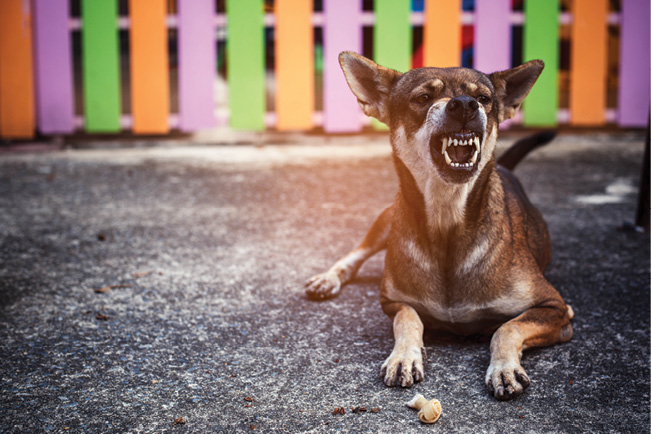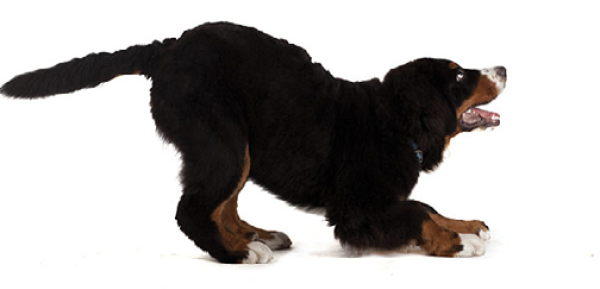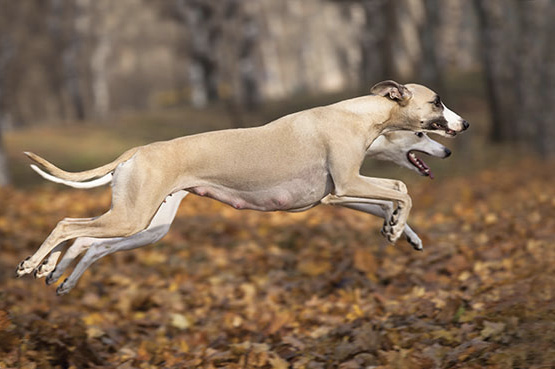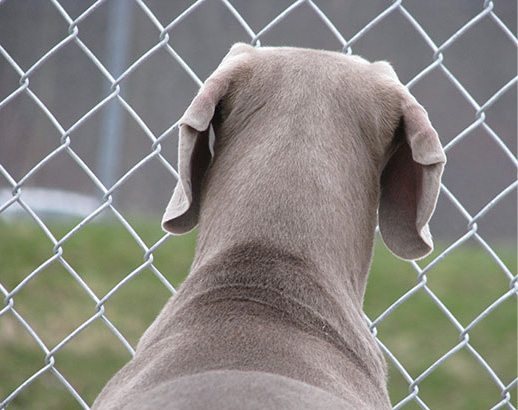Chapter 5: Understand Your Dog’s Aggressive or Reactive Behavior


There is so much folklore about dogs, and we are so fully steeped in it from the time we first utter the syllable “dog” as young children, that it can be very difficult to tease apart what is fact and what is fairy tale. Whether this is your first dog or your fifty-seventh, you have heard that you have to be your dog’s leader, that dogs smell fear, that dogs are pack animals, that dogs are descended from wolves. Am I right? There are elements of truth to all of these views of the nature of a dog, but the extent to which these truisms aren’t the whole story can cause us problems when we need to change our dog’s behavior. This is especially true when our dog is performing risky, aggressive behaviors. They also don’t take into account what a dog learns in his lifetime. Nature and nurture are part of the same whole.
There are some kinds of behavior you don’t have to learn. Let’s say a piece of dust blows into your eye, and you blink. No one had to give you lessons on blinking in that situation; you just did it because that’s how your body is made. This is how many people look at aggression. A person walks in front of a dog, and the dog lunges and bites. The person thinks the dog is hardwired to behave aggressively just as we are hardwired to blink. This is an incomplete view of the behavior.
The very respected animal trainer Bob Bailey likes to say that Pavlov is always sitting on your shoulder. You’ve likely heard of Pavlov, the twentieth-century biologist who started out performing studies on the digestive systems of dogs. In the process, he observed that once the dogs received food from a researcher in a white lab coat several times, the dogs would begin to salivate when they saw the lab coat, even if they didn’t get any food. Pavlov figured out that this pairing of items that were once neutral objects (a lab coat or a bell) with something that was essential for survival (food) resulted in the dogs’ displaying biological responses to food when they saw the guy in the white lab coat or heard that bell.
Animal trainers grabbed on to this principle and started using it to change dogs’ emotional states. For example, if a dog was aggressive toward men, the dog would be given a piece of food every time he sees a man, with the goal of conditioning him to associate the man with the yummy treat. This process is called classical conditioning (or, in modern jargon, respondent conditioning). Procedures using this knowledge are practiced extensively in the rehabilitation of dogs with reactivity and aggression as well as with other species and humans. “Pavlov is on your shoulder” means that, when training animals, we have to remember that classical conditioning is taking place all the time. When the dogs saw the guy with the white lab coat, they naturally salivated because of their past association with the guy in the lab coat and food. A modern trainer offers small treats when a reactive or aggressive dog sees another dog or a person, with the goal of conditioning the dog to feel good when he sees the dog or person instead of feeling aggressive or afraid.

Dr. Rosales used to say, “Yes, Pavlov is sitting on one shoulder, and Skinner is sitting on the other.” B. F. Skinner is the psychologist who founded the field of behavior analysis. Dr. Skinner (who reportedly preferred for his students to call him Fred) identified operant conditioning as a process that takes place naturally in the world, just like classical conditioning. Operant conditioning was the name he gave to learning based on the consequences for the behavior in a certain situation. The outcome may be reinforcing, meaning that it makes the behavior stronger (e.g., the dog sits, you give him a treat, and he is more likely to sit in your presence in the future), or it can be punishing (e.g., the dog sits, a loud siren goes off outside, and the dog is less likely to sit in your presence again). Operant behavior is behavior that happens because it is followed by a desirable consequence (a reinforcer), resulting in the animal doing that behavior more often in the future.
Many people believe that aggression is primarily about inherited traits, but according to the research I conducted under Dr. Rosales’s direction, aggression is operant behavior. When the aggressive behavior happened, it produced a consequence that the dog wanted. Before we started CAT with the dog, the dog’s aggression made something he didn’t like go away or stop happening. That consequence made the dog willing to be aggressive again. During the process of CAT, the dog learned that if he did nicer things, the thing he didn’t like would still go away or stop, so there was no point in getting all worked up about it. And when we completed CAT training from beginning to end, the dog completely changed his mind about the thing he didn’t like, and now he acted friendly toward it. So we’re back to the beginning, where an association changed the emotional response of the dog. He didn’t have to get mad or scared anymore because he knew he could control his world with friendly behavior.

Many trainers believe that they can manage but not change aggression because it is something inherent in the dog (a blink when there’s dust in your eye) instead of something the dog learned (you are more likely to get a treat if you sit for your owner). However, while it’s true that a dog may have been startled the first time he saw a stranger on the sidewalk, if he reflexively growled and that stranger went away—aha!—the dog got a desirable outcome. He got something good out of it.
Our research showed that we could use the same outcome that taught the dog to exhibit aggressive behavior in the first place to reinforce safer and friendlier behaviors—different behaviors than those the dog had chosen. What we discovered was that increasing distance from the scary or otherwise aversive thing made the dog do certain behaviors over and over. If I see a scary guy and I growl, he runs away. Check. I’m going to try that again next time. We know these dogs’ behaviors are susceptible to distance as a reward because we tried it many times with different dogs as well as many times with the same dog. The dogs learned to behave in ways people define as aggressive because their behavior chased the scary or bothersome things away. But guess what? If the scary or bothersome thing went away when they did nice things, they did more nice things. What we had to do was figure out a training situation where we could show them that choosing different behaviors would work for them, and that they would achieve the desired outcome when they behaved nicely, not when they behave aggressively.

A treat when the dog sits reinforces, or strengthens, the desired behavior of sitting.
Dr. Rosales had already been working with students on similar projects for several years before I came along. The first project I participated in involved some fearful but nonaggressive llamas. We waited for a llama to do something we wanted him to do, like take a step toward us, then we dropped a treat and walked away. It was quite effective, although the animals didn’t always eat the treats. Stressed-out animals often can’t eat. In the CAT research, we didn’t bother with treats because we learned that we can purposefully use distance to reinforce nicer behaviors over aggressive ones without food. Food is not useful if the dog is too upset to eat it.
You are going to identify the good behaviors you want to see instead of the undesirable behaviors by doing the observations in Chapter 4. You will create clear descriptions of your dog’s behavior like those that you practiced in your observation exercises. The dog was not doing “nothing” during that break between aggressive actions. He was doing something else. What was it? Sniffing the ground? Turning his head? Looking at his owner? Lying down? Walking away? Stretching? The dog’s interim behaviors are what we are going to reinforce and what we want to see more of. We are going to create a training situation in which the aversive person or dog moves away while the dog is exhibiting benign behaviors instead of while the dog is behaving aggressively (don’t worry; we will take appropriate safety precautions). We will teach the dog that behaving aggressively will no longer work to get the scary guy to go away, but doing other, safer things will.

Turning his head and closing his eyes are neutral behaviors that you’d like to see in place of aggression.
Many positive trainers are concerned about the stress this causes a dog. This is a valid and very important point. All of the training methods that work to reduce or eliminate aggression are stressful on dogs because dogs have to be exposed to things that make them uncomfortable to learn how to be comfortable around them. With humans, a therapist might ask a person to imagine something he or she is scared of at first instead of immediately exposing the person to the real thing, but we don’t know how to do this with dogs. Many modern trainers don’t want their dogs to experience stress, but my view is that we want to introduce minimal stress and show the dog that he can easily change the unpleasant situation. You, as the owner and trainer, will be responsible for setting the situation up in such a way that he can do this. Learning algebra in school is stressful. Learning to swim is stressful. Learning to trust behaviors other than aggression when aggression has worked well for you is stressful. But, rest assured, this procedure will not put any more pressure on the dog than necessary and, in fact, is designed to minimize stress while the dog is learning to trust the effectiveness of his new behavior.

Prong collars were designed to increase agitation in guard dogs. Do not use this kind of provocative gear on any dog.
When we were doing the original CAT research, I made some videos that showed dogs going “over threshold,” meaning that the dog became stressed to the point that he behaved aggressively. Alas, there are four points I want to make about this.
First, for the purposes of demonstrating our work, we often selected videos of aggression incidents to show what we did when aggressive behavior inadvertently happened. It looked like there were many trials in which the dog was pushed too hard. That was misleading. There were many, many more trials in which the dogs did not respond aggressively.
Second, desensitization and counterconditioning, the procedures used by excellent modern trainers, also sometimes result in aggressive responses, so assuming that CAT is unique in that respect is untrue. It goes back to the point I made a moment ago that these dogs are learning something new, and learning is stressful. Sometimes you accidentally get your dog too close to something that worries him. Sometimes something you haven’t identified or controlled changes in the environment. Or sometimes your dog decides to try barking louder and harder because he wants to see if it will work if he is more enthusiastic. There’s stress involved in learning. There just is.
Third, I humbly admit I was pretty new to training dogs at that point. I started training with an aggressive Moluccan cockatoo in the late 1990s, and aside from teaching my dogs to sit, down, and stay using dog treats as rewards from my teen years forward, this was only my second real training experience. But I learned. I got better over time. I finessed my game.
I’m going to confess something: I am glad I was a novice dog trainer when I started because it minimized how much I presumed about dog behavior. I had to pay more attention, and I had to learn to be a very good observer. Be like Zen Buddhists, who say, “First, empty your cup.” Don’t already know everything. Learn to observe like a raptor. Let yourself open up to what you’re going to learn.
And fourth, while I do not recommend going over threshold on purpose, because it could backfire, in the instances when I went over threshold with some dogs, they still learned. They still became friends with me or with my dog. The procedure still worked. If you push and push the dog over threshold time and time again, you will fail. But if it happens accidentally once in a while, be prepared but know the dog is learning something of value. I’ll teach you more about how to deal with going over threshold in the coming chapters.
As I’ve mentioned earlier, the reason we called our procedure Constructional Aggression Treatment was because of the work of Dr. Israel Goldiamond, who produced much excellent psychological research in the 1970s. Dr. Rosales admires his work very much, and he teaches all of his students to study Dr. Goldiamond as well. Dr. Goldiamond’s work involved setting up environments that made it as easy as possible for people to behave better. He then strengthened that better behavior by giving the learners something they liked. He called his work the Constructional Approach because the focus was on constructing, or building, new, preferred behaviors rather than punishing the problem behaviors. When we punish a behavior, we may get that behavior to go away, but there is always going to be another behavior that comes up to replace it. Rather than letting the dog decide on a behavior that creates another problem of its own either for us (maybe he now redirects his bites to his owner because biting the stranger got him in trouble) or for the dog (a life of stress in which, in his mind, he has to fear both his owner and the stranger), in CAT we specifically show the dog what behaviors are going to work. Turn your head? Yep, we’ll make the scary stranger go away. Lunge? Nope, the scary stranger is going to wait until you choose a better behavior—something we can reinforce—before going away. (Don’t get started yet. We need to discuss lot more about the setup before you try this procedure.)

The more you work with your dog, the more you will observe and learn about behavior.
All organisms—dogs, sheep, people, cats, and so on—inherit the ability to adjust their behaviors in ways that make it more likely they will survive and have babies who will grow up and adjust their behaviors to survive, and so forth. Somewhere along the line, your dog’s ancestors’ aggressive responses to threats preserved their lives and let them live on to breed and pass on their genes. What aggressive dogs want, however, is to perform behaviors that get immediate results; something they can see in the here and now. They probably don’t have any concept of what their ancestors did to survive. They just want to do something that will make threatening things (people, animals, objects) go away or stop what they are doing at that moment.
Sometimes, in some situations, a dog will start trying to create distance between himself and whatever he doesn’t like by trying to escape. But running away from a threat isn’t always possible. Maybe the dog is on a leash, maybe he’s in a fenced area, maybe he’s in a kennel, or maybe a scary plumber has come into his home, and he can’t get away. What then? The dog does something that could chase the scary thing away. In no particular order, and possibly with other behaviors swapped in just because, he may freeze and carefully check out the situation. He may growl and then lower his head to get into position and then push off with his back legs, charge forward, and lunge. And maybe bite. These behaviors are scary as all get-out to most plumbers and other interlopers! They usually work, and they learn that this way of behaving almost always pays off. If it doesn’t work one of these times, the dogs just aggress harder, eventually working up to full-on dangerous behavior. Such a dog is labeled “aggressive” by the people around him. Instead of being a dog who was just feeling threatened and wanting some relief, or who wanted to enjoy his own food in peace, he gets the moniker of “aggressive dog.” And that’s not good.
It’s important to note that not all dogs want to chase scary things away. Sometimes a dog wants to interact (play) with someone, so he lunges and barks and leaps, and it looks like aggression. Barking and lunging don’t always mean that the dog wants to hurt someone; sometimes a dog uses these behaviors to try to lure someone into interaction. The CAT treatment as explained in this book will not help these dogs who are are trying to interact socially but, for some reason, haven’t learned to do it properly. What those dogs need are safe opportunities to learn how to play with other dogs. (Not the dog park! Dog parks are full of dogs with unknown behaviors and owners who pay more attention to their cell phones than their dogs.) It can be tricky to figure out the difference between “I want you to go away” and “I want to play with you” because sometimes what people call play aggression can look a whole lot like “I’m going to hurt you” aggression. And some playful dogs do end up hurting people because of their poor social skills.

A scared dog may hide or otherwise try to put distance between himself and the scary thing.
Once I was called to perform the CAT procedure with a Rhodesian Ridgeback mix pup who was just less than a year old. His owners reported that he behaved aggressively around other dogs. I saw a video of his behavior, and it looked pretty fierce. I started to work on CAT with this dog, using my dear late Greyhound, Bravo, as my helper dog. She was a keen reader of dogs’ body language, and I learned to trust her judgment. She was much better at reading dogs’ body language than I will ever be. Bravo, for her part, didn’t seem to find the puppy too worrisome from the very beginning.
We started to work, and I didn’t feel as if we were getting anywhere. The closer Bravo and I got, the more crazed the pup seemed to get. I took a risk that I do not recommend for you unless you have a very strong fence between the aggressive dog and the helper dog. Normally, in the CAT procedure, when the dog behaves in a friendly (or somewhat less worrisome) way, the handler of the helper dog turns and walks away, taking the helper dog with her. (Remember, we’re rewarding the dog with distance from the scary thing.) If the dog behaves aggressively, the handler waits until he calms down before walking away. (There is finesse to this, so don’t start the work yet.)

In this case, I began to approach the Ridgeback with my Greyhound, bit by bit, doing the exact opposite of what we do in CAT with aggressive dogs. We moved closer when he acted better and walked away when he was aggressive, and what do you know? I quickly got close to the pup, and we found a nice, gentle pup who rolled over on his back as soon as my Greyhound got close enough to greet him. This is the opposite of what we do with truly aggressive dogs and will not work with them! The two of them sniffed, interacted, and were gentle and playful with each other. This pup wanted to play, but somewhere along the way, he had learned that barking and lunging were ways to get access to play. Or perhaps he was just frustrated that he never got to hang out with the dogs he was always being exposed to in training classes.
In another case, a Boxer would play roughly with his owner’s boyfriend. The boyfriend would wrestle with the dog on the ground, grab his jowls, and engage in all kinds of roughhousing. Boxers are rough-and-tumble dogs who like to play hard, so this was fine with the dog, but it became a real problem for the girlfriend, who was the dog’s owner. The unfortunate result of all this rough play was that the dog learned that barking, growling, lunging, and even mouthing with a hard pinch of the teeth were the ways to get someone to play. It wasn’t long until his owner could barely handle him. It was quite a circus to teach the dog that rough stuff isn’t fun for most people.
In this case, the couple broke up (I don’t know if it had anything to do with the dog!). Having this guy out of the picture made it easier to eliminate the inappropriate play interactions. The usual routine was that the boyfriend would play with the dog, the dog would get too rough, and the boyfriend would punish the dog. The dog could have been left with no appropriate tools to solicit play. Fortunately, that wasn’t the outcome for this Boxer, who learned how to play more appropriately with his mom, and his mom learned how to help him burn off energy with running and training activities rather than roughhousing.
This Boxer brings to mind something important. The build of the dog often affects his behavior because it affects what he is capable of and good at doing. A muscular breed (e.g., Boxer, Pit Bull, American and English Bulldogs, Bull Terrier) is more likely to play by slamming and ramming into others. Why? Because their stout, muscular bodies bodies are very effective in controlling the behavior of other dogs and even people. If you watch two Pit Bulls playing in an appropriate way, you will likely see them run side-by-side and bump shoulders and hips while opening their mouths toward the other dog’s face and mouth. Sooner or later, they may go tumbling head over heels with each other. This kind of dog play is not usually aggressive, and it is quite fun for them because they’re built for it.
Put two Greyhounds together, and they’re not likely to play this way. There are probably exceptions out there, but in general, that’s not the Greyhound style. What are they going to do? They’re going to run. They have deep chests with big, strong lungs, and they have powerful shoulders and hips to power their long, thin legs. They have long toes to dig into the dirt and propel them forward. They don’t usually ram into each other, at least not on purpose, and some of them will yelp like big, skinny babies (delightful big, skinny babies, I must say) if they have a crash. Greyhounds have thin skin that tears somewhat easily, which is one of the reasons you often see racing or lure-coursing hounds wearing muzzles: to protect them from each other’s teeth in case of accidental pileups. Animals, just like people, do more of what they can do well. Bully breeds slam; sighthounds run.

If you have a purebred dog, he may perform certain breed-specific behaviors because he is good at them. These behaviors have been selected by breeders for many generations over the lifetime of the breed. When dogs are bred for work, the ones who are the best workers are the ones that get to mate and produce babies. The dogs with the most susceptibility to reinforcement for the outcomes of the tasks they’re supposed to perform get to pass their DNA on by breeding with other dogs who are also good at what they do. Border Collies herd. Jack Russell Terriers are vermin hunters and if there is no vermin they will figure out something else to do tenaciously if there are no vermin to hunt. Greyhounds chase rabbits and other critters that run (unless they are like Bravo, who was actually afraid of our cat, Mouse!)

If you have a mixed-breed dog, he may be susceptible to reinforcement for one of his ancestral breeds. One of my current dogs, Aero, who is part Afghan Hound and two parts herding dog (Australian Shepherd and Border Collie) finds the outcomes of herding reinforcing. But with many mixed breeds, you may not see anything that’s necessarily breed-specific in their behavior. You will see dog-specific behavior as well as behavior resulting from the fact that they are living beings in the world. All organisms have the physical capacity to do things (such as creating distance) to avoid things they find aversive.
Choice is an important concern when working with the CAT procedure. In this procedure, we want to give the dog a lot of acceptable, effective choices. The fewer choices an animal has when faced with something aversive, the more likely he is to behave aggressively. If he can’t run away because he’s in a dog run or on a leash, he’s more likely to behave aggressively. He’s run out of choices, so to speak. One of the big challenges for dogs in our modern world is that they can’t choose safe behaviors many times because they’re trapped by the devices we use to keep them safe: leashes, crates, dog runs, fenced yards. I suspect this is one of the reasons there are more reports of aggression in dogs these days than when I was a kid in small-town Oklahoma, where dogs ran loose all day and were called in at night. If they saw a scary dog or person, heck, they could try to hide or outrun him. But now, dogs are contained so that they cannot run into traffic, dig up the neighbor’s garden, get lost or stolen, and so forth. Their choices are all but gone. Since they can’t choose to run, what are they supposed to do? They growl and show their teeth. I am not criticizing safety practices and laws regarding pets, but I do write this with some exasperation because I don’t know the solution to keeping pets safe in a modern world while still providing them with full lives in which they can choose appropriate behaviors most of the time.

Digging is the next-best thing for many Jack Russell Terriers.
Often, a dog’s aggression is orchestrated by us, his owners. Fifteen years before this writing, I adopted and brought home my little dog, Pan. He was about a year old at the time and weighed about 12 pounds. Of course, I thought he needed things, so I took him and Bravo off to the local pet-supply store. A child approached and asked if she could pet my dog, and before I could reply, she reached her hand out to Pan. He snapped. Oh, my! Fortunately, he did not make contact. I was mortified, but I had put my dog in over his head. I had only known him for one day. He had spent months with his brother in a shelter in eastern Texas, so why wouldn’t he be wary of this impulsive small human in this wide-open space full of overwhelming sensory input without his brother for backup?
It was up to me to keep Pan from being overwhelmed, and I hadn’t done it. Now, if the child had chosen to pet Bravo, it would have been a happy day for all because Bravo never saw a child she didn’t adore, but Pan has always been happy to let other dogs be brave while he stands back and sounds the alarm. Pan didn’t bite the child, and has never, to my knowledge, bitten anyone, but he did snap at that child as well as a couple of vets because he was in positions where he didn’t have enough choices in his little doggy toolbox to avoid behavior that could potentially stop their scariness in its tracks.
Interestingly and, obviously, in retrospect, when we switched to another vet in our town, Pan stopped snapping when he was examined. This vet was gentle and smooth, and he paced his exams to suit the little guy’s comfort levels. One vet we saw would sit on the floor to examine my cat, Yoda, instead of putting him on the exam table. Yoda, who had previously needed to be sedated for exams, loved this vet. He rubbed on her and crawled into her lap as she palpated his belly, took his temperature, gazed into his eyes, and even when she opened his jaws to examine his teeth. Giving animals options they prefer often takes away their need to behave aggressively. If you are interested in finding a vet like this, check out the Fear Free Pets website at www.fearfreepets.com. Ask your vet if he or she is Fear Free-certified; if not, suggest that he or she pursues certification.

it’s rare for dogs to get to run free these days.